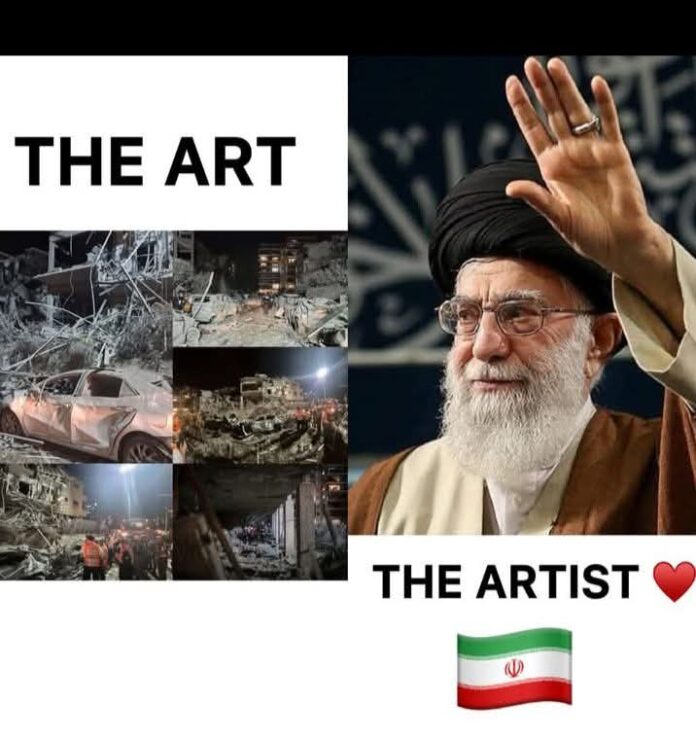Honouring the art and the artist, by Mahfuz Mundadu
They say revenge is a dish best served cold. But what if it’s not just revenge? What if it’s restoration? What if it’s not about anger but art? Not about destruction, but dignity? In the theatre of West Asian resistance, where each missile carries not only a payload but a philosophy, Iran’s response to Israel’s ceaseless provocations was not just a military act, it was a painting in the sky, a ballet of sovereignty, a letter sent not with ink but with precision-guided penmanship.
The signature at the bottom of that letter was unmistakable: Sayyid Ali Khamenei, the quiet storm, the theologian of thunder, the artist in the robe of resistance.
It began, as it often does, with an Israeli miscalculation. A dance of arrogance over Damascus, where their bombs rained like drunken confetti. They struck the Iranian consulate. An act that was supposed to be surgical, precise, professional. But professionalism died a long time ago in Tel Aviv’s war rooms. What remained was performative rage and colonial impunity, nurtured by American indulgence and European silence.
So, they struck. Iran struck back. Not with deniability, not with vagueness, not with masks or mercenaries. They signed their name on the sky, in broad daylight, as if to say: “This is not revenge. This is geometry. This is poetry. This is justice written in supersonic calligraphy.”
It was, in every sense of the word, art.
And as any good critic would tell you, art must be understood not merely in form but in context. To understand the Iranian retaliation is to understand decades of sanctions, sabotage, assassinations, and betrayals. It is to remember the murder of General Qassem Soleimani. It is to recall the silence of the so-called civilized world as scientists were gunned down in broad daylight, as nuclear plants were bombed in the dark, as children in Gaza were turned to dust while Tel Aviv danced. It is to recall that Israel’s dream of being a lion is haunted by its reality: it was born in blood, sustained by deceit, and now fears its own shadow.
But this retaliation, yes, this masterpiece, was not a gaze in the dark. It was a composed lecture, a symmetrical canvas. Over 300 drones and missiles launched in measured and deliberate sequences. Not to massacre, but to make meaning. Not to flatten cities but to lift dignity. Israel’s Iron Dome and its American-provided layers of defense were overwhelmed, not because Iran wanted to kill, but because it wanted the world to see the truth: the empire has cracks, and the emperor’s armor is borrowed.
And Sayyid Ali Khamenei? The artist behind the art? He didn’t roar like a lion. He didn’t bark like a general. He whispered, measured, calm, immovable. The kind of whisper that echoes louder than bombs. The kind of resolve that frightens tyrants. He honoured the blood of his martyrs, not with tweets but with myriad of geometry and calculus as translated by the barrage of ballistic missles trajectory. Not with hashtags, but with hypersonics.
His critics in the West paint him as a relic, a cleric out of time. But the truth is he is more timeless than they are timely.
READ ALSO: Iran becomes first country to shoot down 5th-gen F-35 fighter jets belonging to Israel
While Western leaders change masks every four years, betraying even their own scripts, Khamenei has been consistent: independence, resistance, dignity. While the Israeli Knesset churns through chaos, scandals, and screaming matches, the Leader of the Islamic Republic sits still, speaks sparingly, and moves silently, like the eye of a hurricane.
And this is what they fear most: not fanaticism, but focus. Not irrationality, but reason anchored in faith, strategic restrain, and deterrence. They fear not chaos but a civilization that remembers. That remembers Khaybar and Karbala. That remembers Palestine. That remembers every insult and responds not with rage but with diginified restrain.
Because when you look at Iran’s retaliation, you realize it was not meant to kill. If it had been, Tel Aviv would be ash. Haifa would be rubbles. But Iran is not ISIS. It doesn’t bomb for spectacle. It doesn’t kill to make headlines. It moves with jurisprudence, not vengeance. It is a nation of engineers, philosophers, poets, and martyrs, not mercenaries.
So, Israel was humiliated, not annihilated. It was disarmed morally, not militarily. Its illusion of invincibility was the real target. And the world, even those who dare not say it aloud, took note.
READ ALSO: Iran retaliates, launches over 300 missiles on Tel Aviv, other parts of Israel
What of the West, then? The so-called democracies that fund every Israeli bullet, veto every UN resolution, and condemn every Palestinian breath? They watched, stunned. Their radar operators overloaded, their allies disoriented. Washington sent carriers, not logic. Paris released statements, not shame. London, oh London, the colonial corpse that still believes in its fading magic, tut-tutted and looked the other way.
And yet, amidst all this noise, the silence of Iran spoke loudest.
This was not the act of a rogue state. It was the act of a remembered civilization. One that survived Mongols, Crusaders, Shahs, and sanctions. One that refuses to bow not out of arrogance, but because it already bows only to God. One that responds to violence not with surrender but with strategy.
In Khamenei, that civilization found its mirror. A man who does not need to scream to be heard. Who does not need to run for office to lead. Who does not measure success in barrels or banks, but in dignity retained, martyrs honoured, and resistance passed from father to son, from village to village, from Gaza to Qom.
He is, in many ways, the anti-criminal enterprise of Zionism. Where Bibi thrives on theatrics, Khamenei thrives on principle. Where one fabricates, the other remembers. Where one calculates polls, the other contemplates prayers.
In a world that has confused noise for leadership and selfies for statesmanship, Iran’s retaliation reminded us what real power looks like. It does not announce itself at the UN. It does not beg for legitimacy. It builds it, one response at a time.
So yes, this is about honouring the art. But more importantly, it is about honouring the artist.
Because in an age of war profiteers, Iran responded with restraint. In an era of moral bankruptcy, it acted with diginity. And in a time where silence is complicity, it chose clarity.
History will remember this moment not as a war but as a warning. Not as a battle, but as a boundary drawn in the sand: a line between arrogance and accountability, between the settler and the soul, between the empire and the earth.
Sayyid Ali Khamenei did not fire a single missile. But every missile carried his signature: patient, precise, principled. A masterclass in resistance, a declaration of dignity.
And for once, the world saw it. Not because it wanted to, but because it had no choice.
Because when an oppressed people decide to respond on their own terms, when a wounded nation stops asking for permission to heal, and when the artist becomes the architect of retaliation, no amount of spin, censorship, or propaganda can erase the truth.
They say revenge is an art. But honour, too, is an art. And Sayyid Ali Khamenei, whether his enemies admit it or not, is a master of both.
Follow the Neptune Prime channel on WhatsApp:
Do you have breaking news, interview request, opinion, suggestion, or want your event covered? Email us at neptuneprime2233@gmail.com





